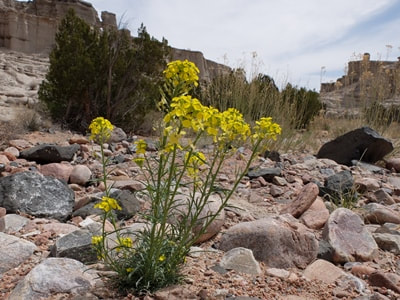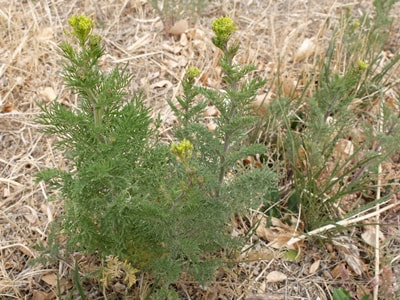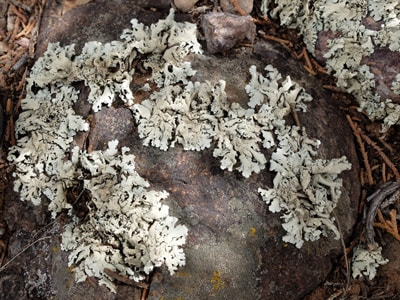|
Found on sandy slopes and rocky ridges
Seen blooming in April on the north rim of Cañon de Cobre Townsend Daisies are commonly called Easter Daisies because they bloom early in the season, often around Easter time. Several species can be found in our area. They grow low to the ground in cushions with flowers nestled low among the leaves, sometimes covering them. The Slender-leaf Townsend Daisy has leaves that are slightly hairy, long, narrow and grayish. The large, eye-catching flowers are white or pinkish, and are about one inch across. Traditionally, Townsend Daisies were chewed or an infusion was taken to ease delivery of a baby, dried plants were used as snuff to clear the throat, a decoction of the roots was given to tired horses, and the plant was used ceremonially. Source. If you trying to identify a different flower then you can check what other flowers bloom this month. If you cannot identify a flower from the website, send a photo and where you took it to [email protected]. Read online for tips.
0 Comments
Found in sandy, rocky soil from the desert to alpine meadows
Seen blooming in April in Plaza Blanca The Wallflower is a common and widespread species. It earned its common name by growing on stone walls in Europe. It grows from a few inches to 30" high with a dense cluster of flowers on an erect stem. Flowers are most typically bright golden yellow but plants in some populations may have tangerine-colored, pink or purple flowers. Each flower has four flat petals and is more than ½ inch across. Seed pods are up to 4 inches long and grow upright, parallel to the stem. In Greek, Erysimum translates as “to help or save” in reference to the medicinal qualities of several species. Practitioners of European folk medicine used wallflower poultices to relieve bronchial congestion, as did Native Americans, who also used dried leaves or seeds to make a tea for stomach cramps and ground the flowers to make yellow paint. Wallflowers are also important sources of food for wildlife, including the caterpillars of a number of butterfly and moth species. Source. If you trying to identify a different flower then you can check what other flowers bloom this month. If you cannot identify a flower from the website, send a photo and where you took it to [email protected]. Read online for tips. Found in disturbed soil, roadsides, sandy areas
Seen in April on CR 142 If you saw this in your yard, you would pull it as a weed, but Herb Sophia has many beneficial properties. It grows from 6 to 30 inches high with a single erect stem, branching in the upper plant as flower stalks grow. Leaves are bright green and feathery, divided into numerous narrow segments. Flattish clusters of flowers bloom at the tip of the branches. Flowers are tiny, about 1/8 inch across, with four yellow petals. Seed pods are one inch long, narrow and point upwards. Native Americans have used Herb Sophia for both food and medicinal purposes. Young leaves and shoots can be boiled and eaten as greens. The seed can be ground, mixed with cornmeal and used to make bread and cakes. Ground seeds were added to water to make a cooling drink or were mixed with snow and eaten as ice cream. Medicinally, a poultice of the plant has been used to ease toothache. The juice of the plant has been used in the treatment of chronic coughs, hoarseness, ulcerated sore throats and asthma. A poultice of ground seeds was used on burns and sores. It is used in the treatment of asthma, fevers, bronchitis, oedema, scurvy and dysentery and as a diuretic, expectorant, laxative, digestive aid and tonic, and in the treatment of worms. Leaves were buried with seed corn to prevent spoiling. Source. If you trying to identify a different flower then you can check what other flowers bloom this month. If you cannot identify a flower from the website, send a photo and where you took it to [email protected]. Read online for tips. Found on trees, logs, rock and soil
Seen in April at Abiquiu Lake So far this year it has been hard to find many plants in bloom, some Purple Mustard, a few Filaree and Dandelions. Although not a plant with a bloom, this pretty lichen on a rock caught my eye. Lichen are interesting and amazing organisms which are actually fungi that cultivate algae for survival. The algae provide the lichen with carbohydrates, vitamins and proteins, while the fungus provides the algae with protection from the elements. The lichen is the product of this symbiotic relationship. Although sometimes plant-like, they are not plants; they do not have roots, stems or leaves. They are slow-growing and can survive in harsh environments on trees, logs, rocks and soil, from hot deserts to the Arctic, and cover about 7% of the Earth’s surface. They convert carbon dioxide in the atmosphere into oxygen and can absorb pollutants in the air. Having lichens growing where you live is a good thing; it means the air you breathe is clean. Lichens have been used for many things by both animals and humans. They provide forage and shelter for elk, deer, birds, and insects. The rufous hummingbird uses it to build its nest. Humans use lichens for dyes, clothing, and decoration, including the tartans of Scotland. A few crofters still produce Harris Tweed using lichen. An added advantage over synthetic dyes is that bitter lichen acids repel moths. A variety of products use lichen in their ingredient lists today, for example, in deodorant, toothpaste, salves, extracts, and perfumes. In Japan, they use lichens in paint for its anti-mildew properties. Lichens in traditional medicine are most commonly used for treating wounds, skin disorders, respiratory and digestive issues, and obstetric and gynecological concerns. Source. There are about 20,000 known species of lichen, I think this is Salted Shield Lichen, Parmelia saxatilis, but I am no expert. An old naturalist joke to remember what lichen is: “Freddy the fungus and Alice the alga met and took a lichen to each other. She thought he was a fungi, but now their marriage is on the rocks.” If you trying to identify a different flower then you can check what other flowers bloom this month. If you cannot identify a flower from the website send a photo and where you took it to [email protected]. Read online for tips. |
AuthorI am Marilyn Phillips, a native of England, whose love of nature and the outdoors from childhood brought me by a circuitous route to Crested Butte, Colorado in 1993 and 16 years later to northern New Mexico. My exploration of the many trails in these areas, my interest in wildflowers and photography, and career in computer system design came together in this creation. If you have any corrections, comments or questions, please contact me by email. Archives
September 2025
Categoriescopyright © 2020
|






 RSS Feed
RSS Feed